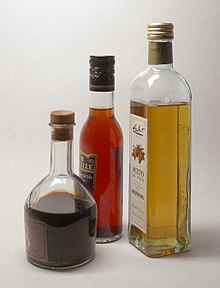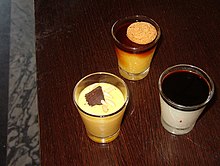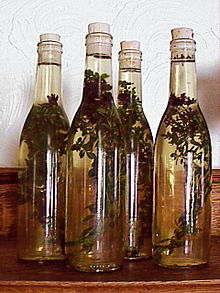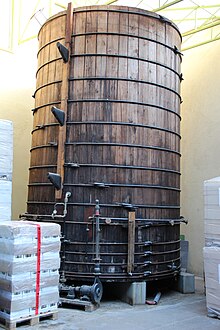vinegar


Vinegar (from Middle High German ezzich ; Latin Acetum ) is a sour- tasting seasoning and preservative that is produced by fermenting liquids containing alcohol with acetic acid bacteria ( mother vinegar ). Vinegar is essentially a dilute solution of acetic acid in water.
Vinegar processing is one of the oldest food production processes known to man. In Germany, vinegar may contain between 5% and a maximum of 15.5% acetic acid according to the regulation on the trade in vinegar and vinegar essence of 1972 ; Vinegar essence maximum 25%. Commercial vinegar usually has an acetic acid concentration of 5% to 6%. Acetic acid or vinegar essence diluted with water is also often referred to as vinegar, but must be declared as such. Vinegar contains only small amounts of alcohol . Glacial acetic acid is a highly concentrated acid (99 to 100%), which accordingly contains very little or no water.
history
Many ancient civilizations - Egyptians , Persians , Romans , Greeks and Babylonians - were already producing vinegar. Vinegar, made from sour fruit juices, wine or beer, mixed with water, was valued as a cooling drink. There are traditions from Mesopotamia that speak of “sour beer”. This product, called "Hequa" by the Egyptians, was brewed from barley and soured from the vinegar. Roman legionaries had a mixture of water and vinegar in their canteens, which they called " Posca ", often the drinking water was not drinkable until then.

The medicinal use of vinegar for respiratory diseases and digestive problems has already been handed down by Hippocrates . L. J. M. Columella , the most important agricultural writer of the first century AD, reports in great detail in his work " De re rustica " about the possibilities of making vinegar. Its starting materials were wine , figs and barley .

In the Middle Ages , herb vinegar in particular was considered a remedy. Hildegard von Bingen , Nostradamus and Florenz von Venningen report in their writings on the mode of action and use of the medicinal plants extracted in acetum sanum . At that time the human body was subjected to various rubs with vinegar, primarily for disinfection . Even in the 18th century, attempts were made to deal with the plague with plague vinegar . Containers and devices used in medicine were cleaned with vinegar. From the 16th century the first taxes were levied on products with or made from vinegar. Pickling vegetables in vinegar and making marinades for salads were particularly popular in France at the time .
In beauty care , vinegar was used because of its cleansing and disinfecting properties up to the treatment of stubborn skin diseases . The violet blossom vinegar of Empress Sisi is still famous today . Today vinegar is mainly used as a preservative , seasoning and luxury food.
Vinegar types
One differentiates between vinegars, on the one hand, according to the type of production and, on the other hand, according to the raw materials used. With regard to production, a basic distinction is made between two different types of production. On the one hand, vinegar can be produced by fermentation using vinegar bacteria, and on the other hand by diluting vinegar essence. Vinegar essence is characterized by an acid content of 25% and is produced on the basis of acetic acid (acid vinegar), which is either obtained naturally by processing wood waste (wood vinegar), especially beech wood, or synthetically. Industrial vinegars are synthetically produced vinegars.

Fermented vinegars
The fermentation vinegars, but correctly fermentation vinegars, are differentiated according to the basic material that is used as the starting material for the alcoholic and subsequent acetic acid fermentation.
| Vinegar type | Vinegar variety | Raw material | Remarks |
|---|---|---|---|
| Brandy vinegar | Brandy vinegar or spirit vinegar, Austria: spirit vinegar | Diluted brandy, brandy mash (sugar beet, etc.) |
|
| Brandy vinegar | Potato cider vinegar | Fermented potatoes, potato brandy |
|
| Brandy vinegar | Vodka vinegar | vodka |
|
| Brandy vinegar | Sugar cane vinegar | Sugar cane |
|
| Brandy vinegar | Whiskey vinegar | whiskey |
|
| Wine vinegar | Red wine vinegar | Red grape wine |
|
| Wine vinegar | White wine vinegar | White grape wine |
|
| Wine vinegar | Sherry vinegar | sherry |
|
| Wine vinegar | Champagne vinegar | champagne |
|
| Wine vinegar | Wine vinegar | Quality wine |
|
| Balsamic vinegar | Aceto balsamic vinegar | Boiled down grape juice |
|
| Fruit or fruit vinegar | Apple cider vinegar, cider vinegar | Apples, apple juice, cider, cider |
|
| Fruit or fruit vinegar | Pear vinegar | Cider pears, pear juice |
|
| Fruit or fruit vinegar | raspberry vinegar | flavored with raspberries |
|
| Fruit or fruit vinegar | Strawberry vinegar | flavored with strawberries |
|
| Fruit or fruit vinegar | Currant vinegar | Fermented currants |
|
| Fruit or fruit vinegar | Plum vinegar | Plums |
|
| Fruit or fruit vinegar | Cherry vinegar | Cherries |
|
| Fruit or fruit vinegar | Grape vinegar (raisin vinegar, date vinegar, fig vinegar) |
Raisins, dates, figs |
|
| Fruit or fruit vinegar | Coconut vinegar | Palm wine made from coconut blossom sugar |
|
| Fruit or fruit vinegar | Banana vinegar | Plantains |
|
| Grain vinegar | Malt vinegar | Malt, barley mash |
|
| Grain vinegar | Beer vinegar | Beer, beer mash |
|
| Vegetable vinegar | Tomato vinegar | tomatoes |
|
| Vegetable vinegar | Cucumber vinegar | Thickened cucumber juice |
|
| Vegetable vinegar | Carrot vinegar | Carrots |
|
| Vegetable vinegar | Beetroot vinegar | Beetroot |
|
| Vegetable vinegar | Asparagus vinegar | asparagus |
|
| Rice vinegar | White and dark rice vinegar | Rice, rice wine |
|
| Whey vinegar | Whey vinegar (milk serum vinegar) | whey |
|
| Honey vinegar | Honey vinegar | Fermented honey, mead |
|
Flavored vinegars or batch vinegars
After production, spices, herbs or fruits can be added to vinegar to influence its taste. Sage, tarragon, garlic, blackberries or raspberries are often used. Mixtures are also common. Brandy vinegar, wine and fruit vinegars are suitable as basic vinegars for these so-called batch vinegars or flavored vinegars. Herbal and spice vinegars belong to the batch vinegars, as do vinegars with an aromatic mixture of different types of fruit and vegetables.
production method
Liquids containing alcohol, for example wine, apple cider , beer , rice wine , or malt brew, or liquids containing sugar such as grape juice, for example for the Aceto balsamico di Modena, can serve as the basis for making vinegar . However, vinegar is mainly made from diluted pure distilled alcohol ( agricultural alcohol ) or from processing wine in the form of the so-called "white vinegar". Vinegar made from distilled alcohol is called brandy vinegar.
For the production of malt vinegar, a grain mash, preferably from malted barley , is first crushed and mixed with hot water. The enzymatic processes involved in this mashing process convert amylose into malt sugar, maltose and grape sugar ( glucose ). This also creates other types of sugar . The sugar-rich liquid is separated and collected via a perforated base. This malt extract is cooled in unhopped form and mixed with yeast ( Saccharomyces cerevisiae ), which ferments the sugar to alcohol and carbon dioxide. The resulting liquid forms the substrate for alcoholisation. The ratio of fermentable sugars and non-fermentable sugars is decisive for the quality of the malt vinegar. The non-fermentable sugars form the flavor components typical of malt vinegar.
The process is often referred to as acetic acid "fermentation" , but it is correctly called fermentation. It is a partial "breathing", since oxygen from the air is required, in contrast to alcoholic fermentation . Therefore, vinegar cannot be produced in closed, unventilated containers. There are several methods of manufacture.
Orléans process (surface process)
The Orléans process is the name given to the open production method in which the starting liquid is inoculated with vinegar bacteria . The fermentation process is left to itself in open vessels. Production is carried out in warm rooms for an accelerated reaction. After a while, the alcohol-consuming bacteria, the so-called mother of vinegar, form a layer of scum on the surface of the liquid . In this way, the alcoholic raw material is slowly transformed into the oxidation product vinegar. Once the alcohol is completely converted into acetic acid, the vinegar is carefully drained under the skin. Some of the vinegar is then stored in barrels, which further improves its aroma through aging processes. This process is more time-consuming than the rapid vinegar process, harbors the risk of “bad fermentation” and is not suitable for large quantities.
This original process was probably discovered by accident, as wine that is left open can sooner or later turn into vinegar on its own. The cause was only discovered in the 19th century when Louis Pasteur provided evidence that small creatures that cannot be seen with the naked eye undergo this transformation process. In his work Études sur le vinaigre , published in 1868, he wrote that “acetic acid fermentation” is a biological process that is carried out by certain bacteria, called Acetobacter or Gluconobacter. These “wild” vinegar bacteria, which are present everywhere, can usually be found themselves when stored open, and the vinegar fly can also be the carrier of the bacteria.
Fast vinegar and chip forming process (generator process)
Sebastian Karl Schüzenbach should be mentioned among the people who tried to improve the production of vinegar - above all to accelerate it. He introduced the rapid vinegar process: since vinegar bacteria work aerobically , they are helped by a floating carrier material, usually wood chips, but also plastic balls on which the bacteria settle and adhere. Since the mother of vinegar is "tied up" on the carrier material, the process is also called a bondage process. The chips increase the surface area on which the vinegar bacteria can settle, and the larger amount of bacteria accelerates the conversion.
With the round pumping or circulation process , the chips are constantly sprinkled with the starting liquid (mash) in a cylindrical container ( vinegar generator or large-capacity generator ), the so-called chip former. The fresh air required by the bacteria is blown in from below. This process is suitable for large-scale production; the fermentation can be completed within a few days to weeks. The disadvantage is the high cost, as the temperature and ventilation have to be constantly regulated. If there is too much air entering, the aroma can be washed out.
A new bondage process replaces the chips with ceramic shards. This makes production cheaper, as the ceramic can be used for practically unlimited purposes.
Submerged process (acetator process), solera process
Submerged processes like that by Otto Hromatka work without a carrier material, the bacteria are directly suspended in the liquid (so to speak submerged, hence the name of the process). Depending on the technology, production takes two to three days in the Venturi process or 24 hours in turbine systems. Turbine systems bring the best results in industrial alcohol vinegar production, venturi processes preserve the color and the fruit character better. The short production time is very economical, which is why most vinegar producers worldwide are switching to the turbine process. The air supply is controlled, as the excessive air entrainment in early systems led to aroma washouts. In the submerged process, the purity of the vinegar cultures used leads to very pure vinegars, which cannot be achieved in the bondage process through mixing with other bacteria.
The Solera system , also known as the Solera method, is a classic approach. The original essence of wine vinegar, which was produced using the Orléans process, for example, is further refined by adding a certain percentage of fresh grape must from the new harvest to the already aged young vinegar in so-called criaderas (rows of barrels lying one above the other) . This process usually works in such a way that only the amount freshly added to the top row of kegs is added that was previously removed for the next row below. This system continues into the bottom row of kegs, with fresh liquid only being added to the top row for inoculation. The partially aged essence is placed in the barrels below. The finished product is always in the barrels in the bottom row. Of course, in the course of the enlargement or renewal of such barrel storage facilities, it is not always possible to keep the process according to the classic system, which is why the essences are pumped around more often or the barrel rows of the first vintages are placed opposite those of the following years.

use

The areas of application of vinegar are very diverse. Among other things, it is used as
- Seasonings , mainly for salads and pickled vegetables and fruits , mixed pickles ,
- important ingredient in the production of table mustard ,
- Pure aperitif or digestif ,
- soft drink diluted with water or juices , the ancient Romans called it Posca ,
- Preservatives ,
- Disinfectants ,
- Natural Remedies ( Apple Cider Vinegar )
- Cosmetic , vinaigre de toilette, in perfumery rose vinegar, orange blossom vinegar and other floral scented vinegars were used, due to their natural disinfecting properties they were used to care for the face and scalp.
- Cleaning agent to remove urine scale and limescale deposits
Simple types of vinegar and commercial vinegar concentrates up to 30% are not only suitable for preparing food, but also for decalcifying saucepans and electric pressure cookers. The effect is accelerated by heating it up to boiling. If more concentrated vinegars such as vinegar essence are used, increased caution is required.
Movie
- Give him a treat - In the world of vinegars. Documentary, Germany, 2011, 29 min., Written and directed: Gerd Ries, production: SWR , series: Essgeschichten, first broadcast: August 24, 2011 on arte, summary by SWR.
literature
- Alfred Wagner: The production of acetic acid, fermentation vinegar, butyric acid, citric acid and lactic acid , 1st volume, chemical-technical library 382nd volume, A. Hartleben's publishing house, Vienna and Leipzig 1926. [1]
- Anne Iburg: DuMont's little lexicon vinegar & oil . Origin - taste - use - recipes. DuMont monte Verlag, Cologne 2002, ISBN 3-8320-8795-8 .
- Julie Townsend: Now it's vinegar! The iconic universal helper for household and kitchen. Premio, Münster 2007, ISBN 978-3-86706-046-2 (Original title: Vinegar: A Guide to the Many Types and Their Uses Around the Home. Arcurus, London 2007. Translated by Nora Boot, Wiebke Krabbe, Geschichte, Essigsorten, Production and use of vinegar).
Web links
Individual evidence
- ↑ Laws on the Internet: Ordinance on the use of vinegar and vinegar essence, April 25, 1972, last amended on July 5, 2017. (PDF; 35 kB), accessed on August 16, 2019.
- ↑ Entry on acetic acid in Pharmawiki , accessed on January 17, 2017.
- ↑ Anne Iburg: DuMonts little lexicon vinegar & oil - origin - taste - use - recipes . DuMont monte Verlag, Cologne, ISBN 3-8320-8795-8
- ↑ vinegars , Kocha, accessed 8 May 2011
- ^ Elisabeth Lambert Ortiz: Vinegar . In: Herbs, Spices & Essences: The Handbook for the Kitchen . Dorling Kindersley Verlag, 2011, ISBN 978-3-8310-9099-0 , pp. 230-231
- ↑ vinegar . In: Meyers Großes Konversations-Lexikon , 6th edition, 1905–1909, p. 119
- ↑ : How is vinegar made? Vom Fass Wien, accessed on May 8, 2011
- ↑ San Chiang Tan: Vinegar Fermentation . ( Memento of the original from September 5, 2012 in the Internet Archive ) Info: The archive link was inserted automatically and has not yet been checked. Please check the original and archive link according to the instructions and then remove this notice. (PDF) Master's Thesis. Louisiana State University 2005
- ↑ Duan SM, Zhao XS, Wen RF, Huang JJ, Pi GH: Stability of SARS coronavirus in human specimens and environment and its sensitivity to heating and UV irradiation. Biomed Environ Sci. September 2003; 16 (3): pp. 246-255. PMID 14631830



